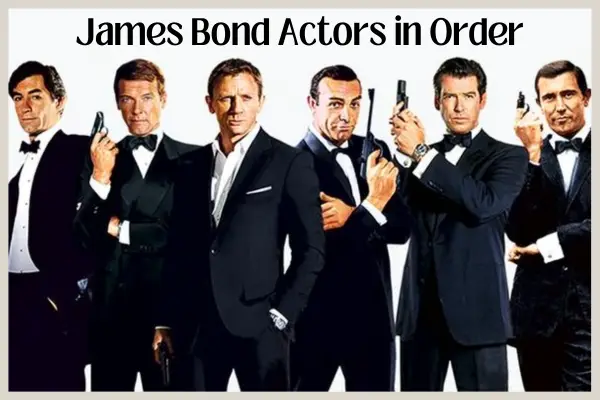All James Bond Actors in Order
In cinema, few characters possess the allure of James Bond. From humble beginnings, the franchise has grown to become a cultural institution, chronicling the tales of all James Bond actors in order.
Drawing inspiration from Ian Fleming‘s pen, 007 emerged from the pages to the big screen, metamorphosing into an emblem of post-war resilience, glamour, and, dare I say, a certain reckless abandon.
The global enthrallment with Bond isn’t solely because he drives the best cars or frequents the chicest parties — although, let’s be frank, those do add to his charm. It’s because, deep down, he encapsulates a timeless fantasy.
Across borders and generations, James Bond stands as a touchstone, weaving a tale of heroism, romance, and an undying hunger for the next adventure.
Six actors have played the character to date, each bringing their unique charisma and interpretation, thus enriching the legacy of all James Bond actors in order. As we embark on this retrospective journey, let us pay homage to these icons and the enduring appeal of 007.
All James Bond Actors in Order
The First James Bond: Sean Connery (1962–1971, 1983)
Sean Connery, the enigma with a Scottish lilt. The cinema had seen leading men before, but none who quite embodied the allure and panache that Connery brought to the silver screen.
Born in the heart of Edinburgh in 1930, a young Connery found his early days steeped in humble beginnings, with a world far removed from the glitz of Hollywood. And yet, destiny, with its idiosyncratic whims, chose him to be the pioneer, the first face of the James Bond character, setting a gold standard for all who dared follow.
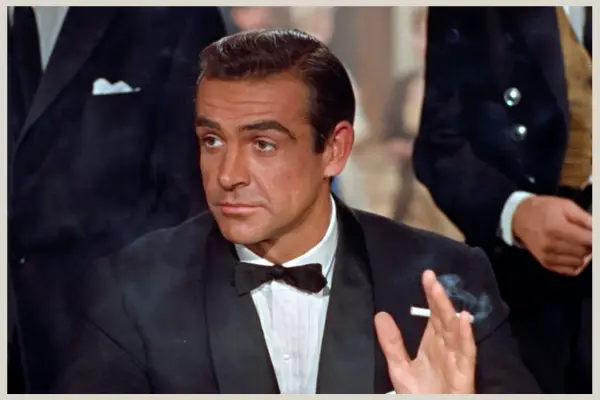
His journey as 007 commenced with the first Bond movie, Dr. No, in 1962, a film that, in its essence, wasn’t just about a British spy but about establishing an archetype. The subsequent celluloid adventures — From Russia with Love (1963), the iconic Goldfinger (1964), the water-filled escapades of Thunderball (1965), the culturally rich You Only Live Twice (1967), and rounding off with his comeback and abdication in Diamonds Are Forever (1971) — were not just films.
Some better than others, but they were era-defining spectacles, each one etching Connery deeper into the annals of cinematic greatness. Yet, the siren call of Bond was hard to resist, drawing Connery back for unofficial Bond film, Never Say Never Again in 1983, a title that in itself cheekily acknowledge the actor’s second return.
One cannot mention Connery’s Bond without recalling some of his signature moments. That first introduction in Dr. No, cigarette in hand, uand the immortal “Bond, James Bond” introduction with an unmatched coolness. The jetpack ascent in Thunderball was a breathtaking spectacle that epitomizes Bond’s blend of technology and audacity, and of course, Connery’s almost balletic finesse in action sequences.
Sean Connery transcended the mere act of portrayal. In the eyes of a multitude, he didn’t just play Bond — he embodied him, became him. A veritable symphony of charm, peril, and sharp wit, Connery’s Bond left an indelible mark so profound that even Fleming felt compelled to rewrite Bond’s heritage, infusing it with a touch of the Scottish.
2nd: George Lazenby (1969)
The second of our James Bond actors, George Lazenby, is a bit of an enigma. His tenure as Bond was brief, yet in that short span, he left an indelible mark on the annals of the 007 legacy.
Born in Goulburn, Australia, in 1939, Lazenby’s route to the cinematic zenith was hardly conventional. From selling cars to becoming the highest-paid male model in London, his journey was as serendipitous as it was extraordinary.
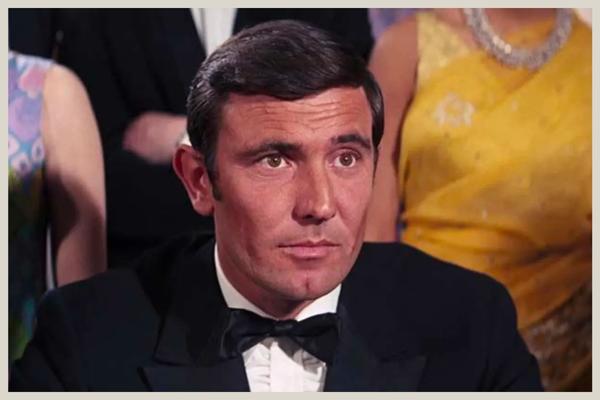
The singular film he adorned as Bond, On Her Majesty’s Secret Service (1969), is nothing short of a cinematic curio. It’s a film that dared to tread where others didn’t, imbuing the invincible Bond with vulnerability, depth, and an emotive resonance. Here was a Bond who loved and lost, a stark contrast to his often steel-clad cinematic persona.
But Lazenby’s time as Bond was not without its tumults. Rumors swirled, painting a narrative of a man at odds with his own burgeoning fame. Tales whispered of a young actor, fresh in the limelight, clashing with his cast members, some even suggesting he had grown too big for his well-polished boots.
And just as the world was warming up to this new face of Bond, Lazenby, ever the maverick, chose to walk away. By the time the film graced theaters, he had already hung up his Walther PPK, driven by the belief that cinema’s grand stage had many more roles in store for him.
Perhaps the most poignant moment of Lazenby’s Bond comes at the film’s conclusion in his new wife Tracy‘s murder. A scene brimming with raw emotion, a scene where 007 faces the fragility of life itself. It was a moment that showcased not just Bond’s humanity, but also Lazenby’s depth as an actor.
In the end, George Lazenby remains an enigma — a fleeting yet unforgettable chapter in the grand tale of James Bond, forever remembered as the one who dared to both embrace and defy the legacy.
3rd: Roger Moore (1973–1985)
The third of all James Bond actor in order was Roger Moore — a name that effuses a certain regal charm, where British refinement meets unbridled charisma.
Born in the leafy suburbs of Stockwell in 1927, Moore’s journey was as intricately textured as the finest Savile Row suit. Trained at the Royal Academy of Dramatic Art, and with a career that spanned from modelling to television, by the time he arrived at the Bond stage, he was no stranger to the spotlight.
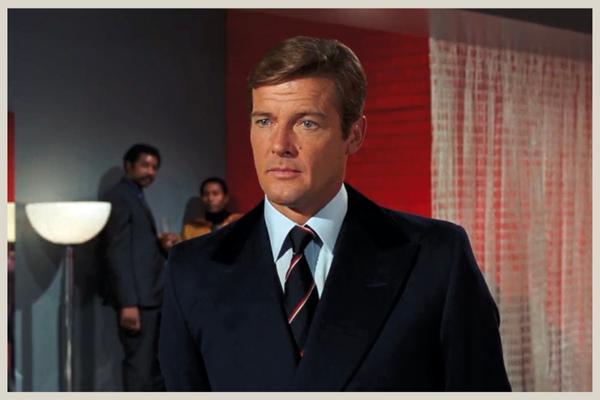
Stepping into the iconic shoes of Bond in Live and Let Die (1973), Moore presented the world with a 007 that was markedly different from his predecessors. His Bond was suavely comedic, with arched eyebrows and quips that became as emblematic as the Walther PPK.
The subsequent films — the orient allure of The Man with the Golden Gun (1974), the grandeur of The Spy Who Loved Me (1977), the galactic audacity of Moonraker (1979), the nuanced For Your Eyes Only (1981), the vibrantly exotic Octopussy (1983), and the cold war tones of A View to a Kill (1985) — all showcased the chameleonic grace of Moore’s Bond.
Moore’s tenure was filled with moments that are now etched into the cinematic zeitgeist. The audacious crocodile stepping stones in Live and Let Die, the car that transformed into a submarine in The Spy Who Loved Me, or that gravity-defying ski jump that leaves one gasping even today.
But perhaps what made Roger Moore’s Bond truly special was the actor’s ability to evolve with the times. His 007 was a reflection of the changing societal landscape, bringing to the role a blend of traditional charm and modern sensibilities.
In the vast galaxy of Bond actors, Roger Moore shone with his distinct hue — a Bond who could charm you with a smirk, whisk you away on an adventure, and leave you both exhilarated and yearning for more.
4th: Timothy Dalton (1987–1989)
The fourth actor to don the tuxedo, Timothy Dalton emerges as something of a tantalizing enigma — a brooding, intense and arguably misunderstood iteration of 007.
Born in the historical town of Colwyn Bay, Wales, in 1944, Dalton’s roots are firmly planted in classical theatre. Trained at the Royal Academy of Dramatic Art, his early years saw him breathing life into Shakespearean roles, imbuing them with an intensity that would later become a hallmark of his Bond.
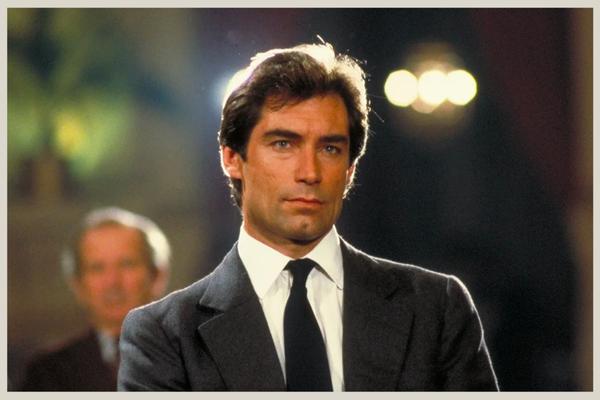
Dalton’s 007 tenure, while brief, brought with it a seismic shift in Bond’s portrayal. In The Living Daylights (1987), audiences were introduced to a Bond who was less the playboy and more the introspective professional, bringing a gravitas that was both arresting and, for some, jarring. This trajectory continued into Licence to Kill (1989), where Bond’s personal vendetta gave audiences a glimpse of the spy’s raw, visceral side.
Notable moments? They abound. From the dramatic orchestral opening of The Living Daylights that saw Bond sliding down a snow-covered mountainside to the darker, revenge-fueled undertones of Licence to Kill where he dangles a villain from a helicopter — Dalton’s Bond was one who could oscillate between cold fury and passionate dedication.
Yet, while his portrayal garnered admiration, it also divided. For an audience weaned on Moore’s charm and witticisms, Dalton’s serious, even tormented Bond seemed almost out of sync.
But here lies the crux — Timothy Dalton was, perhaps, a Bond before his time. In an era leaning towards larger-than-life escapades, Dalton brought a realism, a depth, that would only truly be appreciated in later years.
Today, with the luxury of hindsight, many have come to view Dalton’s interpretation as groundbreaking. His 007 laid the groundwork for a more nuanced, human Bond, paving the way for future portrayals.
In many ways, Dalton’s Bond was a harbinger, a prelude to a more introspective 007 — proving that sometimes, to truly appreciate the depth of the ocean, one must first let the ripples settle.
5th: Pierce Brosnan (1995–2002)
Our fifth James Bond actor, Pierce Brosnan is a name that evokes a symphony of suave elegance interwoven with a distinctly modern flair.
Born in the coastal town of Drogheda, Ireland, in 1953, Brosnan’s journey from a young artist in London to becoming one of the most recognizable faces in Hollywood is nothing short of cinematic in its own right.
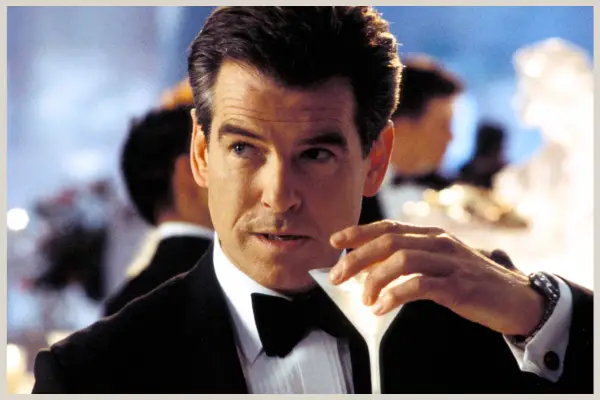
Before taking up the mantle of 007, Brosnan was already etching himself into the popular consciousness with roles that showcased his versatility and undeniable charm.
By the time the mid-90s rolled around, audiences were yearning for a new face, a fresh iteration of Bond, and in GoldenEye (1995), Brosnan delivered with aplomb. Here was a Bond who married the charm of Moore with the intensity of Dalton — a modern 007 for a post-Cold War world.
The subsequent films, the techno-thriller Tomorrow Never Dies (1997), the emotionally charged The World Is Not Enough (1999), and the audaciously futuristic Die Another Day (2002), all showcased Brosnan’s ability to seamlessly blend into the evolving tapestry of the Bond universe.
Who could forget the daring bungee jump from the Contra Dam in GoldenEye? Or the exhilarating motorbike chase through the streets of Saigon in Tomorrow Never Dies? Then there was the poignant moment in The World Is Not Enough where Bond confronts his own feelings for Elektra King, a depth of emotion rarely seen in 007’s character.
But what truly set Brosnan’s Bond apart was his impeccable timing. He arrived at a moment when the world was transitioning, both technologically and culturally. His 007 was sophisticated yet approachable, classic yet contemporary, embodying the duality of the late 20th and early 21st centuries.
In the grand narrative of James Bond, Pierce Brosnan stands as a bridge, a beacon that illuminated the path from the legacy of the past to the promise of the future. With a twinkle in his eye and a multitude of firearms in hand, Brosnan’s Bond reminds us that sometimes, to move forward, one must first acknowledge and embrace the echoes of the past.
The most recent James Bond: Daniel Craig (2006–2021)
The last of our James Bond actors in order is Daniel Craig, who oozes words such as ‘revolutionary’, ‘raw’, and ‘redefining’ spring to mind.
Born in the quaint city of Chester in 1968, Craig’s early life was infused with the artistic pulse of theatre. From the gritty streets of Liverpool’s Everyman Theatre to the refined corridors of London’s National Theatre, he honed his craft with an unwavering commitment.
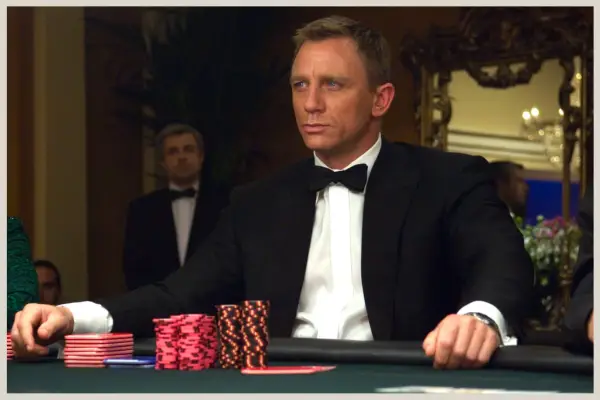
Then came 2006, and with Casino Royale, the world witnessed a rebirth of Bond. Gone were the laser watches and invisible cars. In their place stood a Bond that was visceral, vulnerable, and violently human. Craig’s piercing blue eyes mirrored the depths and complexities of a spy caught in a modern world, struggling with the weight of his own soul.
Quantum of Solace (2008) further explored this tormented psyche, while Skyfall (2012) delved into Bond’s origins, painting a hauntingly beautiful portrait of a man and his demons. Spectre (2015) weaved the threads of his past into a tapestry of intrigue, and finally, No Time to Die (2021) offered a poignant farewell, a denouement to Craig’s epoch-defining tenure.
The moments that define Craig’s Bond are countless. The exhilarating parkour chase at the beginning of ‘Casino Royale’, setting the tone for a more grounded, athletic, and relentless 007.
The hauntingly intimate confrontation with Raoul Silva in Skyfall, which tugged at the very fabric of Bond’s identity. And who could forget the raw emotion of No Time to Die, a testament to both Bond’s humanity and Craig’s unparalleled portrayal?
Daniel Craig’s Bond was much more than a return to the roots, it was a profound exploration of what it means to be a hero in a fragmented world. His 007 was scarred, often broken, yet unwaveringly resilient — a reflection of the modern human condition.
In the grand opera of Bond, Daniel Craig was its rawest, most heart-wrenching aria — a symphony of pain, love, and undying duty. With Daniel Craig, James Bond bled, cried, loved, and with a quiet intensity, redefined an icon for a new generation.
>> Get the full James Bond Collection <<
All James Bond Actors in Order
As the curtain draws on our retrospective journey, encompassing all James Bond actors in order, one cannot help but marvel at the talent and narratives that have graced the silver screen.
From Connery’s quintessential charisma to Craig’s raw vulnerability, each actor has infused the character of James Bond with a unique essence, reflecting the zeitgeist of their respective eras.
The role of 007 stands as a testament to the diversity of manhood, showcasing the myriad facets of what it means to be a hero. And as the world now stands on the cusp of another chapter, the air is thick with anticipation.
Whispers fill the air on who will be the next to take over the keys to the Aston Martin DB5. But as we ponder the future, let’s also revel in the past. We invite you, dear readers, to watch again at some of the most classic moments in cinema history.

